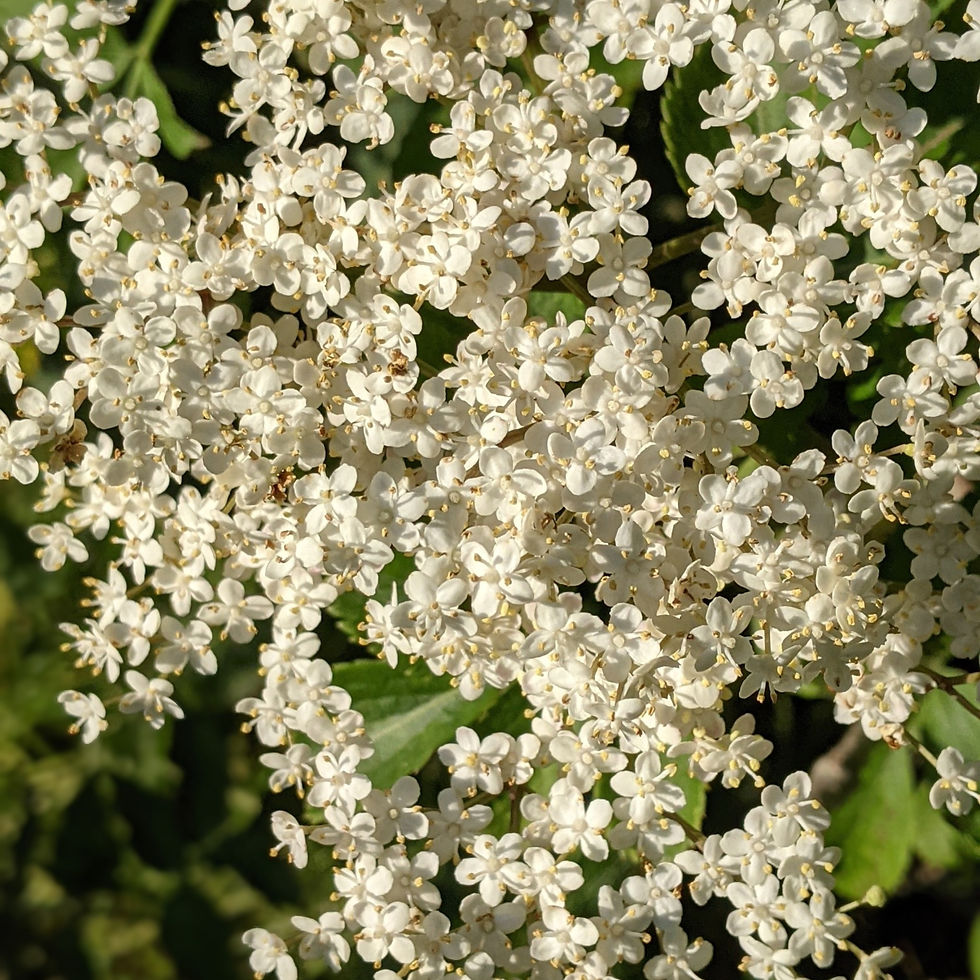Strawberry and Elderflower Cordial
- The Cramlington Forager

- Jun 20, 2021
- 3 min read
Updated: Nov 2, 2022
A refreshing spin on the time honored summer classic.
If you've only ever dabbled with wild food, I could hazard a guess and say you've either enjoyed Autumn days spent rummaging the hedgerows for blackberries, or you've filled a basket with the sweet smelling blossom of the Elder Tree to ferry home to make Elderflower cordial.

Every year I make Elderflower Cordial, and every year my family decides that they don't like the flavour! I almost decided not to make it this year, but decided to have an attempt at trying something new in hopes that I could change their minds (or their tastebuds).
This recipe combines two of Summer's greatest offerings into one delicious cordial- Elderflowers and sweet, sweet strawberries. My own strawberries are nowhere near ready thanks to the strange weather we had in May, so I used the sweetest store-bought strawberries I could find. I spent a sunny afternoon foraging for Elderflowers around the Westview Allotments, carried them home and brewed it all together only to add way too much citric acid in the final stages. So the first attempt did not turn out at all well! But the great thing about Elderflowers is that they bloom in such abundance that it was no problem to try again. This time I got it right, and oh my - it's delicious!

I really wanted to make this in time for the Summer Solstice, and I can see this recipe being brought out every year as part of my family's budding solstice traditions. So far it's proved to be an all round crowd pleaser and it really is very simple to make. Elderflowers are also easy to identify which makes this a great foraging recipe to get the whole family involved with.

Strawberry and Elderflower Cordial
Makes about 2 litres
Ingredients
10 large Elderflower heads
200g Sweet strawberries
2 L Water
12oz Sugar
1tbsp Citric Acid
Leave your flowerheads outside for about an hour to allow for all the little bugs to escape. You want to avoid washing your flowers so pluck off any dirt and leaves that you can.
Gently snip away as much of the stalks and stems from the flowers as you can, and add the flowers to a large pan. Discard the stems.
Hull and quarter the strawberries, and then add them to the pan along with 2 litres of water.
Bring to the boil and then simmer gently for about 15 minutes with the lid on, or until the strawberries are soft and pale. Remove from the heat and leaving the lid on, leave for around 12 hours to allow the fruits and flowers to continue to infuse the liquid.
Strain out the strawberries and Elderflowers using a scalded muslin cloth. Add the liquid to a clean pan and discard the pulp.
At this point you'll want to prepare your bottles, ready to have them to hand as soon as the cordial is ready. I use two clip-top Kilner bottles, washed in warm soapy water and then dried in a low temperature oven for 15 minutes. You'll need them to be hot when you add your hot cordial to create a successful seal on the bottle.
Add the sugar and citric add to the pan and heat gently until all of the sugar has dissolved. The liquid should have turned thick and syrupy. Its now ready to be bottled. From this point onwards only sterilized equipment should come into contact with the cordial to avoid bacteria from growing. So if you're using a funnel, make sure that is sterilized too!
Pour your cordial into your bottles. Fill to the top, leaving just enough room for the lid. Seal immediately, . If done right, as the bottle cools it should create an air-tight seal.
The cordial should last for at least a few weeks if you're storing in the fridge.
Serve ice cold diluted with water, mixed with lemonade or even gin. Try adding a spring of mint, it really enhances the flavour!

_JPG.jpg)






Commentaires